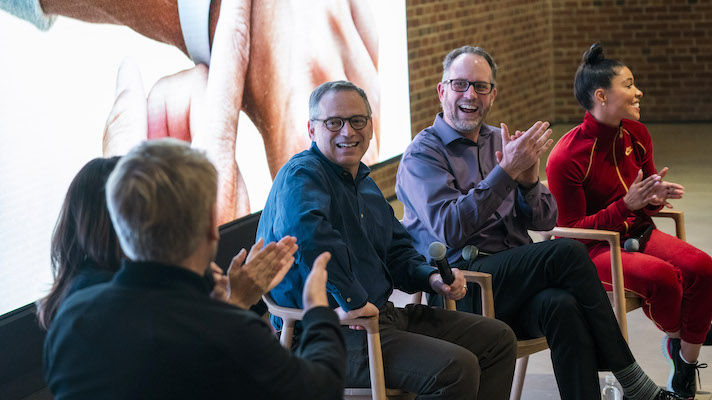
Photo courtesy Apple.
With the addition of FDA clearances for the ECG sensor and irregular heart rate algorithm, the Apple Watch is now technically a medical device. But it is still primarily a consumer product, and its fitness features may still have the greatest impact on people’s health, according to a panel of health professionals — three doctors and celebrity trainer Jeanette Jenkins — who spoke at a recent event at the Williamsburg Apple Store in Brooklyn, New York.
“I’ve worked in the health and wellness space for more than 30 years and my goal has always been to inspire as many people as I can to live a healthy life, and every year I’m reminded of that massive statistic that heart disease is the number one killer in the world and it still shocks me,” Jenkins said. “It’s so highly preventable for many, many people.”
Apple Director of Fitness and Health Technologies Jay Blahnik moderated the panel, which consisted of Apple VP of Health Dr. Sumbul Desai; Dr. Harlan Krumholz, director of the Center for Outcomes Research and Evaluation at Yale-New Haven Hospital; Dr. John Rumsfeld, chief innovation officer for the American College of Cardiology; and Jenkins.
The doctors on the panel spoke broadly about how patient-generated healthcare data is starting to revolutionize how they do their work.
“I see this as an emerging trend where people aren’t just coming in and saying ‘Tell me what to do,’ but people are wanting to be part of that partnership. It’s their lives, it’s their health, and I’m seeing engagement at a level I’ve never seen before,” Krumholz said. “I’m not here to sell anything, but I’m telling you that things like the Watch and other sensors … are going to inform people about their lives in ways we’ve never seen before and provide the opportunity for discussions that are not just about ‘How have you felt?’ or ‘What have you been doing?’ But the discussions can even start by looking at data together that can help us to be better informed about where people are. So I’m very excited about where we stand. I think this is going to be a new era.”
But there are challenges as of now. Rumsfeld said that his colleagues are already starting to see this data — and struggling to make use of it.
“Even though this has just been recently released, I just came from a meeting of all cardiologists who specialize in the electrical heart system and almost all of their patients are sending in, from the Apple Watch, the tracings,” he said. “They’re getting them all the time. We now have the problem of, that’s really high-quality information, we still have to change the system so it actually gets in in a way that’s useful. But I think we’re right on the cusp of this digital transformation of healthcare, I really do.”
Krumholz agreed, noting that right now the doctor is generally looking at the report on the patient’s phone.
“We’re ill-equipped in this moment to be fully integrated,” he said. “But believe me, in a very short time medicine’s going to be able to, or else you’re going to go somewhere else. Because you’re going to look for people who are going to be able to take in your information, listen to you as a true partner, work with you in a way that respects and honors who you are.”
Another challenge is making sure people are using the sensors in the way that best promotes good health. One of the most interesting moments in the panel came when an audience member asked the panel how often her mother should take an ECG with her Apple Watch. Desai replied that Apple doesn’t actually encourage people to use the feature in a routine or arbitrary way.
“This is really intended for the use of if you’re feeling something and you want to capture it and talk to your doctor, that’s what it’s meant for,” she said. “It’s not meant for just randomly taking ECGs. If you want to do it once or twice, great, but in general it’s really meant for a specific case of capturing a situation.”
Krumholz elaborated on how, from his perspective, that kind of use could be problematic.
“We don’t want to create a whole bunch of people who all they’re doing is worrying because of the information,” he said. “So we’re trying to figure out what the right balance is. And we think the balance might be, if you do have something and can’t figure out what it is, that might be [a good time to use the feature] because you want to check it out with your doctor. But most of the time people are fine. And they shouldn’t be in an obsessive mode, like, I have to check 20 times a day.”
And that brings us back to the Watch’s fitness features, as Blahnik took the opportunity to make a different suggestion for the audience member.
“Share activity with her and start getting her obsessed with closing her activity rings,” he said. “That’s something she can obsess about.”














